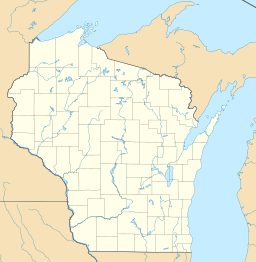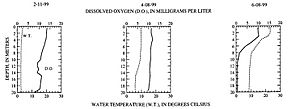Little Muskego Lake facts for kids
Quick facts for kids Little Muskego Lake |
|
|---|---|
| Location | Waukesha County, Wisconsin |
| Coordinates | 42°54′54″N 88°08′33″W / 42.91500°N 88.14250°W |
| Type | Mesotrophic |
| Primary inflows | Jewel Creek |
| Basin countries | United States |
| Max. length | 2,092.15 m (6,864 ft) |
| Max. width | 902.96 m (2,962 ft) |
| Surface area | 470 acres (190.2 ha) |
| Average depth | 14 m (46 ft) |
| Max. depth | 65 m (213 ft) |
| Water volume | 7,170 acre⋅ft (8,844,064.8 m3) |
| Surface elevation | 244 m (801 ft) |
Little Muskego Lake is a cool lake located in Muskego, Waukesha County, Wisconsin. It's connected to the Fox River by a smaller stream. The lake is home to plants like muskgrass and water celery. You can also find some plants that aren't native to the area.
People love to visit Little Muskego Lake for fun activities. You can go boating, swimming, waterskiing, and even ice fishing in winter. If you like fishing, you'll mostly catch bass and panfish here. The lake is about 14 meters (46 feet) deep on average and covers an area of 190.2 hectares (470 acres).
Contents
Lake Basics: Where is Little Muskego Lake?
Little Muskego Lake sits on top of something called the Troy Valley Bedrock aquifer. This is like a huge underground sponge made of sandstone, with layers of clay and rocky soil. Most lakes in this area were formed about 10,000 years ago. This happened when a giant ice sheet, called the Laurentide ice sheet, melted and moved away.
How Does Water Flow in the Lake?
Little Muskego Lake is a "drainage lake." This means most of its water comes from a stream called Jewel Creek, which flows into the north end. Water then flows out of the lake into Muskego Creek, Big Muskego Lake, Wind Lake, and finally the Fox River.
The lake is also known as a mesotrophic lake. This means it has a medium amount of nutrients, which is good for plants and animals. The Wisconsin DNR helps manage the lake. They lower the water level a little bit each September and October. This "drawdown" helps control unwanted plants in the lake.
A Look Back: History of the Lake Area
The first people to live around Muskego were the Potawatomi tribe. In 1827, the first Europeans arrived. Within five years, the Potawatomi gave their lands to the U.S. Government. More European settlers came, and by 1839, many Norwegian families had moved to the area.
What's in the Water? Lake Chemistry
In 1999, the average pH of Little Muskego Lake was 7.8. This number tells us how acidic or basic the water is. The water temperature can change a lot. It can be as cold as 0.5 degrees Celsius (32.9 F) in winter and as warm as 26.67 degrees Celsius (80.01 F) in summer.
Scientists use a tool called a Secchi disk to measure how clear the water is. In Little Muskego Lake, the average Secchi depth was 1.65 meters (5.41 feet). This means you could see the disk down to that depth. The lake is also called a dimictic lake. This means its water layers mix completely twice a year, usually in spring and fall.
Keeping the Lake Clean: Pollutants
The main things that can pollute Little Muskego Lake are phosphorus and heavy metals. A lot of the phosphorus and dirt that enters the lake comes from nearby farms. It's estimated that a large amount of phosphorus (between 767 and 2275 kg) gets into the lake every year.
As more farms and wetlands around the lake turn into towns and cities, scientists expect heavy metal pollution to increase. To help with this, a plan was made in 1993. The goal was to reduce pollution from different sources, especially by cutting down on dirt and phosphorus entering the lake.
Plants and Animals: Flora and Fauna
Little Muskego Lake is home to many different kinds of plants and animals.
Plant Species in the Lake
In 1994, a plant called muskgrass (Chara vulgaris) was the most common plant in the lake. You can also find water celery (Valisneria americana) and different types of pondweed. A survey in 2002 found 17 different plant species living in the lake.
However, some plants that are not native to the lake have also moved in. These "invasive" species include starry stonewort (Nitellopsis obtusa) and Eurasian water milfoil (Myriophyllum spicatum). To control these unwanted plants, people lower the lake's water level, use special treatments, and even harvest the weeds. In 2020, over 900 loads of weeds were removed from the lake! The Lake District also encourages boat inspections and teaches people how to stop invasive plants from spreading. The DNR has a program called "Clean Boats, Clean Waters" to help with this.
Fish and Wildlife in the Lake
Little Muskego Lake is a great place for fishing and wildlife. It's especially known for its bass and panfish. But you can also find walleye, northern pike, catfish, and other types of fish. You can fish for yourself, but commercial fishing is not allowed.
Hunting for waterfowl (like ducks) and trapping animals are only allowed in the city of Muskego, not on the lake itself. Animals like muskrats, beavers, squirrels, and cottontail rabbits are common near the lake's edges. You might also see mallards, wood ducks, and blue-winged teal flying around.
One invasive animal species found in the lake is the zebra mussel (Dreissena polymorpha). These mussels can cause problems for the lake's ecosystem.
Fun on the Lake: Recreation
For many years, from 1861 to 1977, Little Muskego Lake was home to a fun place called Muskego Beach Amusement Park (later DandiLion Park). It eventually closed, partly because of competition from bigger parks like Six Flags Great America.
Today, the lake is still a popular spot for fun. People enjoy boating, swimming, fishing, and waterskiing. In the winter, you can go cross-country skiing, snowmobiling, and ice fishing. The Muskego Recreation Program offers classes and activities on the lake. There's even a local waterskiing team called the Muskego Waterbugs! The Little Muskego Lake Association was started in 1968 to help take care of the lake.



